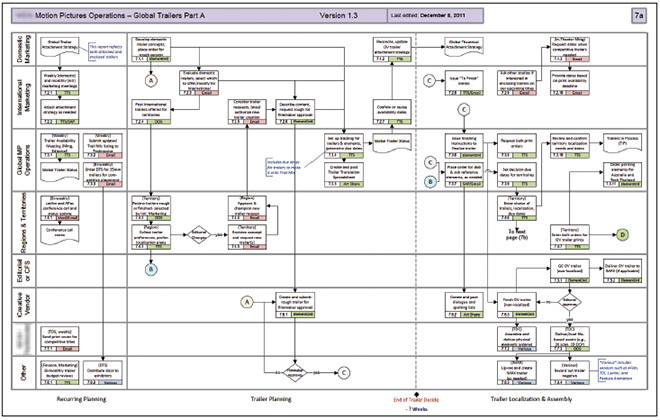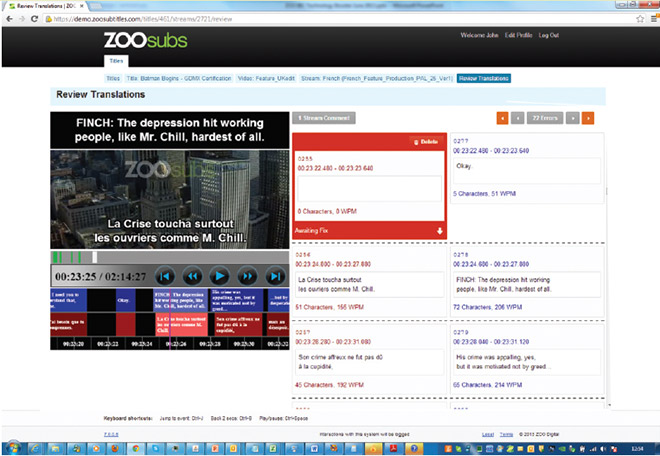Europe's online source of news, data & analysis for professionals involved in packaged media and new delivery technologies
Cloud control - Transforming creative and production process management

Consumers' insatiable appetite for localised filmed and TV entertainment has led to enormous challenges for producers and distributors alike to deliver huge volumes of content. STUART GREEN, CEO of ZOO Digital, says the answer lies in the Cloud.
It seems that only a few years ago, when it came to distribution of film and TV content in the home entertainment industry, DVD was the only game in town. Today, the array of device, format and media choices available to consumers is staggering. This, coupled with consumers' insatiable appetite for localised filmed and TV entertainment around the world has led to enormous challenges for content producers and distributors alike. These stem primarily from the demands of delivering huge volumes of digital entertainment in today's markets.
When you consider that this transition has taken place to a backdrop of a challenging economic climate it is no wonder that companies throughout the industry are under extreme pressure to cut costs and improve efficiencies.
Enter the cloud
There can be no doubt that this change has been brought about by astonishing advances in technology, which includes the meteoric rise of cloud computing. Although they may not realise it, 95% of consumers have come to depend heavily on cloud-based services in areas such as digital locker services like UltraViolet, social networking and email.
Now more and more creative and production companies are turning to the cloud to help increase productivity and reduce costs. According to the 2nd Cloud Circle Industry Trends Survey of senior business, finance and IT-based personnel, saving money and improving agility/flexibility are the two most common reasons for adopting the cloud.
Innovators have been quick to capitalise on the many advantages of cloud computing to offer a range of new services for packaged media and digital delivery. There are now many areas of work where the traditional approach of one-user-one-workstation has been displaced by cloud computing, including collaboration, review/approval of materials and workflow automation. 'The cloud' is not a well-understood term (apparently 29% of respondents of a recent survey thought it was for forecasting the weather!) So, let's get technical for a moment: cloud is a computing resource that is:
- On-demand: the servers are already setup and ready to be used;
- Self-service: the customer chooses what he/she wants, when he/she wants it;
- Scalable: the customer can choose how much capacity he/she wants and ramp up if necessary;
- Measurable: there's metering/reporting so you know you are getting what you pay for.
What makes cloud services so attractive to many businesses is the way that they are charged - customers pay only for what they use, when they use it. This makes cloud services much more cost-effective than traditional approaches to computing and is allowing many organisations to become more competitive, profitable and agile.
Cloud and the media industries
With so much to gain, why then, on the whole, have media organisations been relatively slow to embrace cloud services? There are a number of reasons. Ironically, one of the biggest is that businesses are so busy doing what they know best and fighting fires that there's no time left in the day to step back and see what benefits new approaches can bring.
In an effort to make their workforce more efficient, businesses may choose to install new information systems. However, a common pitfall is that new systems usually bring new working practices and procedures which take time to learn. As a result, productivity can actually go down rather than up when a new system is rolled out. If operators are under pressure then introducing new systems can easily backfire if not done right.
Before we explore how media companies can tackle this dilemma, let's take a look at how and why cloud-based platforms are beginning to take hold as an alternative to the conventional approach. Traditionally, a business hires an IT team to build and run its computer systems. This means spending cash up-front on servers and software. Once those systems are up and running the IT team will make sure they continue to be so, which includes continually updating software and computer security. So, there's a significant capital cost and an on-going cost of a dedicated IT team.
Contrast this with systems hosted in the cloud. Businesses no longer need to purchase, install, host and maintain their own hardware: servers can be 'rented' - by the hour, if needed - so that start-up costs require almost zero cash. Starting up a new service, or increasing capacity to deal with a peak requirement, such as a big transcoding job, can be activated in moments and charged on a pay-as-you-go basis. This means that businesses pay only for the infrastructure they need, when they need it.
The business model that has proven to be most popular is Software-as-a-Service, or SaaS, where software developers make available a complete package of certain functionality that customers can tap into as and when required, scaling resources up and down as needs dictate. Under a SaaS arrangement the service provider takes care of all those tedious maintenance tasks, such as bug fixes and computer security updates. SaaS solutions are usually designed to be resilient, which means that in the event of, say, hardware or network failure, customer services are uninterrupted.
Under an arrangement like this there is usually no significant requirement for traditional IT management at the customer site at all - maintenance and user support are provided directly by the SaaS company. Consequently, the cloud democratises IT - it allows any business or workgroup of any size to access the kind of services that were previously accessible only to the largest enterprises.
The implications of these benefits to the broadcast industry were highlighted in a recent conference on the cloud hosted by the IBC. Opening the event, Bob Harris, CTO with Channel 4 Television in the UK, explained how his investigations into cloud computing began in 2008. His team developed web applications to support two E4 TV series. The ability to automatically scale up the cloud-based computing resources to respond dynamically to consumer demand as viewers switched on to the applications during commercial breaks enabled Channel 4 to deploy a robust, scalable solution at minimal cost.
Harris explained how there are many misconceptions surrounding the cloud, which should be dispelled as Channel 4's cloud model is proven to be secure, reliable and scalable on account of its three most fundamental features: self-service, pay-as-you-go pricing and 'elastic computing.' The latter refers to the capability of cloud systems to dynamically increase or decrease ?resources in order to maintain a consistent level of service irrespective of the demands that are being placed by users.
Many businesses are reluctant to adopt the cloud due to security concerns, but Harris explained that cloud security today is designed to meet the most demanding requirements of corporate IT departments, including his own.
Other industry speakers at this conference described a range of applications that are proving valuable and cost effective. These include video transcoding (the encoding of video streams to support the wide range of formats now required for digital delivery across multiple distributors), where solutions such as Amazon Elastic Transcoder and Microsoft Azure Media Services are proving popular.
File transfer solutions, such as Aspera and Signiant, designed for moving very large data sets (such as video materials) between content originators, post production facilities and distributors are being delivered using cloud infrastructure. Applications that have been delivered traditionally on the desktop are also moving to the cloud, including the controversial Adobe Creative Cloud which makes the erstwhile Creative Suite toolset available on a SaaS licensing model.
There has been an increasing trend amongst organisations throughout the digital media and entertainment industries to make greater use of automation as a means to improve operational efficiency. Coupled with the move to centralizing operations, the cloud is proving to be an effective way to support enterprise video workflows. Considerable efficiencies can be delivered when automation and centralised operations are employed for distribution and playout.
Workflow is the key
The unifying characteristic across all of these areas is workflow; many of the challenges faced by businesses today concern the management of workflows. According to the dictionary, a workflow is "the sequence of industrial, administrative, or other processes through which a piece of work passes from initiation to completion." I'll use the term to refer to all of the things that a business (and its partners) has to do in order to provide a certain service or to develop a type of product.

In most aspects of creative media production, wherever this occurs within the industry, the efforts of multiple individuals must be co-ordinated to deliver the outputs that meet client requirements, within budget, timescale and to quality standards. The commercial success of many businesses today is directly linked to how efficiently these workflows are operated. Consequently, management of workflows is increasingly a strategic capability.
Let's look at an example to explore the importance of efficient workflow management in businesses today. Consider a small marketing agency engaged by a film studio to create advertising materials for a forthcoming feature across a number of territories. Creative concepts must be circulated for review by multiple managers throughout the client's organisation; text must be translated; localised artwork must be checked by native speakers; various iterations of multiple items will be produced and versions must be controlled meticulously. Managing such a process to tight deadlines can be onerous and vulnerable to human error.
If this sounds to you like project management, then let's be clear about how the efficient management of workflows and projects differ. Project management is normally applied to one-off undertakings, which are probably unlikely to be repeated, such as the installation of new equipment. In contrast, workflow refers to activities that are performed repeatedly, to deal with a business area that is undertaken time-and-time again, usually a routine part of a business' remit (e.g. creating advertising materials).
The reason to make this distinction is that operating workflows occupy the majority of the time of most businesses, and there is usually an excellent opportunity to systematise workflows through the judicious use of IT in order to dramatically improve repeatability, consistency and quality.
Cutting overheads by half
What we have found is that most media businesses use very simple tools to help them manage even complex workflows, usually Microsoft Excel and email. This can work fine up to a point, but as the number of simultaneous jobs increases it becomes onerous and error prone. In practice it limits the number of jobs each project co-ordinator can reliably handle, which means that administrative overheads are high.
ZOO has worked with a wide range of media groups and we typically find that, with the support of the right software, project co-ordinators can at least double their throughput. Or, put another way, administrative overheads can be reduced by at least half.
So, here's the dilemma: how can a business make the changes necessary to deliver these kinds of savings without disrupting day-to-day operations? We have learned that the answer lies not in making staff learn new workflows, but rather in providing systems that proactively support the existing workflows. In other words, businesses continue to capitalise on the procedures that have already been proven to be successful, but draw on computer systems to automate their administration.
A new generation of workflow management solutions is being enabled by the power of cloud computing. Businesses involved in many aspects of digital media production and distribution are turning to cloud workflow management to allow established and proven working practices to be performed much more efficiently. By using flexible, configurable platforms, bespoke systems can be assembled very quickly and inexpensively, optimised for the specific characteristics of the target business environment. The implementation can be tweaked and adjusted over time to ensure that it continues to meet the evolving needs of the business.
CASE STUDY: Let the cloud work the crowd
A Los Angeles-based digital media production facility serving a number of major international content owners wanted to add subtitle origination and formatting to its range of services. Having previously outsourced subtitle production to specialist third parties, management felt that a suitable collaboration system would enable greater control over projects and their quality, selection of preferred translators and reduction of costs. In addition, centralising subtitle materials would allow reliable archiving and management of data. The challenge was doing this quickly and without significantly increasing headcount or incurring hefty start-up costs.

With the aid of cloud-based systems, the facility has been able to manage the efforts of an extensive network of freelance translators located around the world, increasing the number of concurrent jobs by over 100, without any increase in admin staff. One centralised system has become the hub of subtitling operations, allowing translators, QC staff, project co-ordinators and clients to collaborate effortlessly. The system provides full visibility of project progress and status. An added bonus is that creating subtitle files for compatibility with a range of formats, from DVD and Blu-ray to digital platforms like iTunes, are generated automatically and on-demand, reducing cost and shortening turn times.
In addition to the above case study, here are two other examples:
Collaborating on international marketing
The theatrical marketing group of a major Hollywood film studio used Excel and email to manage the development of international campaigns. With lead times shortening, project co-ordination was becoming harder and mistakes were starting to creep in. The group adopted a workflow management system to support the production and localisation of poster campaigns for 40+ languages, incorporating secure online review and approval, reducing time to market by half. This was done with the minimum of disruption of day-to-day business by capitalising on the workflows already operated by the group.
A self-service portal for clients
In an increasingly competitive market, a UK-based POP agency was looking for a way to streamline the way it handles communications with a number of its key clients. A workflow management system was put in place to support client self-service, making it easier for clients to submit orders, review and mark up artwork and track progress. The system reduces emails and automates aspects of client administration, reducing costs. The clients, now able to obtain real time status information, are delighted with the interface that is tailored for their needs.
Cloud computing is changing working practices to dramatically improve the efficiency of creative and production businesses. By automating administration, businesses become more productive. When materials and processes are centralised there is better visibility and collaboration becomes easier. By capitalising on existing workflows, systems can be designed that cause the least possible disruption of day-to-day operations. In combination, cloud-based workflow management enables cutting costs and improving efficiencies.
STUART GREEN has led software companies since the early 1990s. Since 2006 he is CEO of ZOO Digital Group. With a PhD in Computer Science from the University of Bristol, he brings a technical edge to the leadership of the company. In the early days of ZOO, Stuart initiated the research which led to a range of new methods to simplify the preparation of interactive video products. He has also invented a number of the core algorithms used by ZOO's proprietary software; Stuart has more than 20 granted patents in the fields of image processing and media transformation. Contact: www.zoodigital.com....
On predicting the future

Predicting the future, let alone the future of packaged media, is a perilous exercise, and possibly counter-productive, as the exercise closes doors rather than keep them open, argues JEAN-LUC RENAUD, DVD Intelligence publisher. Consider that: Apple was left nearly for dead 15 years ago. Today, it became the world's most valuable technology company, topping Microsoft.
Le cinéma est une invention sans avenir (the cinema is an invention without any future) famously claimed the Lumière Brothers some 120 years ago. Well. The cinématographe grew into a big business, even bigger in times of economic crisis when people have little money to spend on any other business.
The advent of radio, then television, was to kill the cinema. With a plethora of digital TV channels, a huge DVD market, a wealth of online delivery options, a massive counterfeit underworld and illegal downloading on a large scale, cinema box office last year broke records!
The telephone was said to have no future when it came about. Today, 5 billion handsets are in use worldwide. People prioritize mobile phones over drinking water in many Third World countries.
No-one predicted the arrival of the iPod only one year before it broke loose in an unsuspecting market. Even fewer predicted it was going to revolutionise the economics of music distribution. Likewise, no-one saw the iPhone coming and even fewer forecast the birth of the developers' industry it ignited. And it changed the concept of mobile phone.
Make no mistake, the iPad will have a profound impact on the publishing world. It will bring new players, and smaller, perhaps more creative content creators.
And who predicted the revival of vinyl?
(click to continue)... Read More...



















